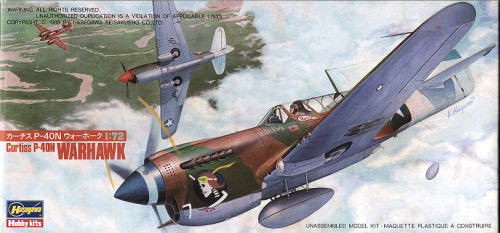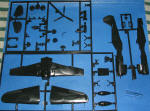
| KIT: | Hasegawa 1/72 P-40N Warhawk |
| KIT #: | 510 |
| PRICE: | 500 yen |
| DECALS: | Two Options |
| REVIEWER: | Scott Van Aken |
| NOTES: | 1988 basic boxing |

| HISTORY |
The P-40 was one of those aircraft which would be characterized as 'the best that we have for the moment'. Though nearing obsolescence even when the war broke out for America in late 1941, the truth was that there wasn't anything better to be used. More potent aircraft like the P-38, P-47 and P-51 were being developed and wouldn't see combat for a year at the best. So, like in all wars, one fights it with what one has and hopes for the best.
Fortunately, the P-40 had already been tried in combat by the British in North Africa and so the results of that experience were added to the later versions coming off the line. Truth is that at low level, the P-40 was a pretty good fighter. A bit heavy compared to some, but able to withstand a lot of damage and able to carry a respectable load of ordnance. An experienced pilot was able to do well in the Warhawk if they took advantage of its heavy armament and high diving speed to do hit and run attacks. In a dog-fight, especially against Japanese planes, it was not at its best.
Even when it was surpassed by other types, the P-40 soldiered on until late 1944 with the USAAF in the Pacific/CBI and even longer with some Allied nations. The most widely produced version was the P-40N. It was a result of extensive weight reduction and had the most powerful Allison engine that would fit into the airframe. It was also equipped with drop tank or bomb racks and provided good service in the fighter-bomber role. All but the very early P-40Ns could be distinguished by the altered canopy section to the rear that provided better rear view. Not surprisingly, most surviving P-40s are this version.
| THE KIT |
 Hasegawa
jumped on the engraved panel line bandwagon in the early/mid 1980s and this was
one of a number of WWII fighter kits that they produced. It was still before the
'do multiple versions with one basic set of sprues', but you'd also find the two
larger sprues with their P-40E kit; the smaller one with the fuselage containing
the N specific bits.
Hasegawa
jumped on the engraved panel line bandwagon in the early/mid 1980s and this was
one of a number of WWII fighter kits that they produced. It was still before the
'do multiple versions with one basic set of sprues', but you'd also find the two
larger sprues with their P-40E kit; the smaller one with the fuselage containing
the N specific bits.
Even though tens of thousands of these kits have been produced, this one only shows a tad of wear with a teeny bit of flash on one part and some small sink areas on the lower wings near the tips. Both easy to repair. Probably the weakest part of this kit in the minds of many is the cockpit section. There is a generic tub with molded in seat and a control stick. The instrument panel blank is set to accept a decal. Much of this Spartan approach still continues with Hasegawa 1/72 kits, though not quite to this degree. Fortunately for us all, there are aftermarket resin cockpit sets for these kits so we can really fix things up. The canopy is a one-piece affair and quite clear. Unfortunately, the one in this kit has been banged around a lot and tore free from its sprue, leaving a scarred attachment point that will require some effort to smooth out. Vacuform replacements are also available for those interested.
Wheel wells are a respectable depth and have sufficient detail for most. Gear are well done and quite scale as are the diamond tread tires. Again, resin replacements are available. Some consider the prop to be a bit narrow, but it looks fine to me. The only underside options are a single bomb or drop tank.
 Markings
are provided for two aircraft. One is the box art plane from the 49th fighter
group's 7th fighter squadron based in New Guinea during 1944. It carries the
white tail section and wing leading edge typical of tactical aircraft operating
in this theater. Some think that the upper side of the tail planes was not
painted white so you may wish to do more research. The other is from the 89th
fighter squadron, 51st fighter group based at Assam, India during 1944. This
carries one of the unit's fearsome looking skull markings. These were each
individually painted so no two planes had exactly the same one. Both planes are
in OD over Neutral Grey with blue spinners. Decals are typical of Japanese kit
decals until quite recently. That means they are a bit thick, the white is
actually ivory and they hate setting solutions of any kind. However, using very
hot water seems to be the trick if you wish to use either of these markings.
Markings
are provided for two aircraft. One is the box art plane from the 49th fighter
group's 7th fighter squadron based in New Guinea during 1944. It carries the
white tail section and wing leading edge typical of tactical aircraft operating
in this theater. Some think that the upper side of the tail planes was not
painted white so you may wish to do more research. The other is from the 89th
fighter squadron, 51st fighter group based at Assam, India during 1944. This
carries one of the unit's fearsome looking skull markings. These were each
individually painted so no two planes had exactly the same one. Both planes are
in OD over Neutral Grey with blue spinners. Decals are typical of Japanese kit
decals until quite recently. That means they are a bit thick, the white is
actually ivory and they hate setting solutions of any kind. However, using very
hot water seems to be the trick if you wish to use either of these markings.
| CONCLUSIONS |
I have built a number of these kits, both right from the box and with the addition of aftermarket goodies. They make into very nice models and while not as new as the Academy versions, I still think that you'll be pleased with the results.
September 2006
Thanks to me for providing this kit for you.
If you would like your product reviewed fairly and quickly by a site that has nearly 325,000 visitors a month, please contact me or see other details in the Note to Contributors.